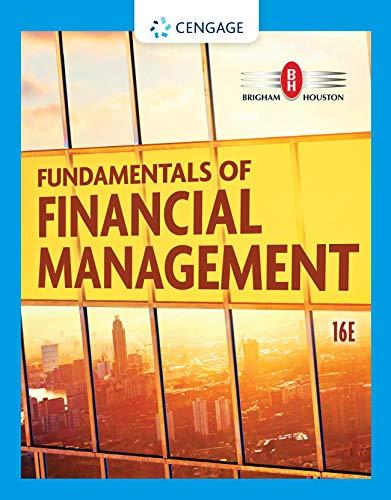Question
Kelly Pitney began her consulting business, Kelly Consulting, on April 1, 20Y5. The accounting cycle for Kelly Consulting for April, including financial statements, was illustrated
Kelly Pitney began her consulting business, Kelly Consulting, on April 1, 20Y5. The accounting cycle for Kelly Consulting for April, including financial statements, was illustrated in this chapter. During May, Kelly Consulting entered into transactions. In Part 1 of this problem, the accounting cycle was completed up through the preparation of the adjusted trial balance.
| Required: | |||||
| 8. If you completed the end-of-period work sheet in Part 1, use the adjusted trial balance figures to prepare an income statement, a statement of owners equity, and a balance sheet. If you didnt complete the end-of-period work sheet in Part 1, use the ledger (the Excel spreadsheet) to prepare an income statement, a statement of owners equity, and a balance sheet. Be sure to read the instructions above each statement carefully. | |||||
9.
| |||||
| 10. Prepare a post-closing trial balance. |
Chart of Accounts
| CHART OF ACCOUNTS | |||||||||||||||||||||||||||||||||||||||||||||||||
| Kelly Consulting | |||||||||||||||||||||||||||||||||||||||||||||||||
| General Ledger | |||||||||||||||||||||||||||||||||||||||||||||||||
|
| ||||||||||||||||||||||||||||||||||||||||||||||||
Labels and Amount Descriptions
| Labels | |
| Current assets | |
| Current liabilities | |
| Expenses | |
| For the Month Ended May 31, 20Y5 | |
| May 31, 20Y5 | |
| Property, plant, and equipment | |
| Amount Descriptions | |
| Decrease in owners equity | |
| Increase in owners equity | |
| Kelly Pitney, capital, May 1, 20Y5 | |
| Kelly Pitney, capital, May 31, 20Y5 | |
| Net decrease in cash during month | |
| Net income | |
| Net increase in cash during month | |
| Net loss | |
| Total assets | |
| Total current assets | |
| Total expenses | |
| Total liabilities | |
| Total liabilities and owners equity | |
| Total property, plant, and equipment | |
| Withdrawals |
Journal
| 9. A. | Prepare the closing entries on Page 8 of the journal. Refer to the chart of accounts for the exact wording of the account titles. CNOW journals do not use lines for journal explanations. Every line on a journal page is used for debit or credit entries. CNOW journals will automatically indent a credit entry when a credit amount is entered. |
| 9. B. | Add the appropriate posting reference to the closing entries in the journal in CengageNOW. |
PAGE 8
JOURNAL
| DATE | DESCRIPTION | POST. REF. | DEBIT | CREDIT | |
|---|---|---|---|---|---|
| 1 |
| Closing Entries |
|
|
Use the spreadsheet completed in Part 1 of this problem to complete the following steps of this problem. Your input into the spreadsheet will not be included in your grade in CengageNOW on this problem.
| 9. B. | Post the closing entries to the ledger of four-column accounts. |
Income Statement
8. If you completed the end-of-period work sheet in Part 1, use the adjusted trial balance figures to prepare an income statement. If you didnt complete the end-of-period work sheet in Part 1, use the ledger (the Excel spreadsheet) to prepare an income statement. Be sure to complete the statement heading. Refer to the Chart of Accounts and the list of Labels and Amount Descriptions for the exact wording of the answer choices for text entries. Enter amounts as positive numbers unless the amount is a calculation that results in a negative amount. For example: Net loss should be negative. Expenses should be positive. You will not need to enter colons (:) on the income statement.
| Kelly Consulting |
| Income Statement |
8. If you completed the end-of-period work sheet in Part 1, use the adjusted trial balance figures to prepare a statement of owners equity. If you didnt complete the end-of-period work sheet in Part 1, use the ledger (the Excel spreadsheet) to prepare a statement of owners equity. Be sure to complete the statement heading. Refer to the list of Labels and Amount Descriptions for the exact wording of the answer choices for text entries. For those boxes in which you must enter subtracted or negative numbers use a minus sign.
| Kelly Consulting |
| Statement of Owners Equity |
8. If you completed the end-of-period work sheet in Part 1, use the adjusted trial balance figures to prepare a balance sheet. If you didnt complete the end-of-period work sheet in Part 1, use the ledger (the Excel spreadsheet) to prepare a balance sheet. Be sure to complete the statement heading. Refer to the Chart of Accounts and the list of Labels and Amount Descriptions for the exact wording of the answer choices for text entries. You will not need to enter colons (:) or the word "Less" on the balance sheet; they will automatically insert where necessary. Enter all values as positive amounts. When entering assets, enter them in order of liquidity.
| Kelly Consulting |
| Balance Sheet and posting trial balance |
Step by Step Solution
There are 3 Steps involved in it
Step: 1

Get Instant Access to Expert-Tailored Solutions
See step-by-step solutions with expert insights and AI powered tools for academic success
Step: 2

Step: 3

Ace Your Homework with AI
Get the answers you need in no time with our AI-driven, step-by-step assistance
Get Started


